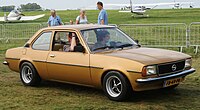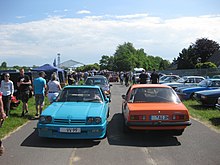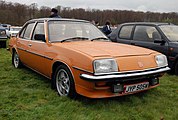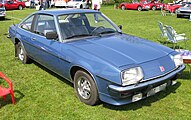Opel Ascona B.
| Opel | |
|---|---|
|
Opel Ascona four-door (1975–1981)
|
|
| Ascona B | |
| Production period: | 1975-1981 |
| Class : | Middle class |
| Body versions : | limousine |
| Engines: |
Otto engines : 1.2–2.0 liters (40–81 kW) Diesel engines : 2.0 liters (43 kW) |
| Length: | 4321 mm |
| Width: | 1670 mm |
| Height: | 1380 mm |
| Wheelbase : | 2518 mm |
| Empty weight : | 900-1100 kg |
| Previous model | Opel Ascona A. |
| successor | Opel Ascona C. |
The Opel Ascona B is a mid-range sedan from Adam Opel AG , Rüsselsheim and was presented in September 1975. It was the successor to the Ascona A built from November 1970 and the last Ascona on the GM-H platform with rear-wheel drive . It had the same technology as the Opel Manta B coupe presented at the same time .
The two- or four-door sedan was manufactured in Bochum and Antwerp , a station wagon version ("Caravan") like the Ascona A did not exist. In Great Britain , the type was offered as a right-hand drive with a front section similar to the Manta B under the name Vauxhall Cavalier Mk. 1 . In South Africa the model was on the market as Chevrolet Ascona or Chevrolet Chevair .
Model history
General
The successor to the Ascona A presented at the IAA in 1975 differed from its predecessor in that it was smoother and more functional in terms of design. The Opel Ascona was only available as a two- and four-door sedan, with a station wagon variant (as was still available on the previous model) was dispensed with.
At the beginning there was the type with the well-known and proven four-cylinder in-line engines from the predecessor, but some of them performed a little less due to stricter emission regulations. The petrol engines had a displacement of 1.2 to 2.0 liters with 44 to 81 kW (60 to 110 hp) and the two-liter diesel had 43 kW (58 hp). In addition, with the Ascona SR, there was a sporty equipment line in the range, but only with 1.6-l, 1.9-l and 2.0-l engines.
The Ascona B was visibly more spacious than the Ascona A, which was originally planned as a successor to the Kadett B and was only launched on the market as a new mid-range model in the course of its development. The wheelbase was lengthened by 8.8 cm, the body grew by 20 cm in length and 4 cm in width, while it was half a centimeter lower. The appearance of the Ascona B corresponds to the Opel design language of the 1970s with smooth body and large glass areas and the Rekord D and the Kadett C ajar.
Opel ended the production of Type B in 1981 after 1.5 million vehicles.
technology
The tank was located behind the rear seat bench so that it was safe from impact, which also made the trunk larger than its predecessor. The 1.2-liter side cam engine was based on the engine of the Kadett A presented in mid-1962 , while the larger ones were based on the CIH engine of the Rekord B presented in mid-1965 .
From August 1976 the 1.2-liter N-engine with 40 kW (55 PS) was added, which did not make the almost 1000 kg heavy Ascona B really lively, but like the new 55 kW (75 PS) that was also offered at the same time. strong 1.9-liter N-engine got by with regular gasoline. From September 1977 the 2.0-liter S with hydraulic valve lifters and 74 kW (100 hp) replaced the 1.9-liter S engine, followed by the 2.0-liter N with 66 kW (90 hp) in March 1978 ), which was also equipped with hydraulic valve lifters.
For the first time there was a new 2.0-liter diesel engine for the Ascona from September 1978 (source: Opel) with 43 kW (58 hp), which was also available with an automatic transmission. Above all, it should address the taxi industry. Similar to the Rekord E, the diesel required a characteristic hump on the bonnet because the machine was slightly higher. The 1.6 S dropped out of the range in the summer of 1977. All models now had an electric windscreen washer as standard.
In February 1979 the 1.3 N models with 44 kW (60 PS) and 1.3 S models with 55 kW (75 PS) were added. This had newly developed engines with light metal - cross-flow cylinder head and an overhead camshaft (OHC). They replaced the technically overhauled OHV engine that had been developed for the Opel Kadett A at the end of the 1950s. As with the 2.0 N and 2.0 S, the mixture preparation of the 1.3 S was carried out by a downdraft register carburetor GMF Varajet II (Varajet - "Variable Nozzle") from the French GM production (GMF = General Motors France) Solex PDSI from the OHV or normal gasoline models does its job.
In August 1979, slight detail changes were made. The Ascona received a radiator grille with larger air inlet slots and bumpers with a black plastic coating instead of the previous one made of chrome-plated steel with a rubber strip.
From January 1980, the 2.0 E-CIH engine (E stands for L-Jetronic injection from Bosch) with 81 kW (110 hp) , which had already been introduced in August 1977 in the Manta and Rekord E models, was also available for the Ascona . In January 1981, Opel removed the 1.9 N and 2.0 N engines from its range of engines.
In August 1981 production ended in favor of the successor Opel Ascona C , which had been converted to front-wheel drive .
Special models
- Ascona Winterfest (1978; only as 2.0S)
- Ascona J (1980; with all engines)
- Ascona Sport (1980; only as 1.3 S and 2.0 E)
- Ascona JS (1981; as 1.3 N, 1.3 S and 2.0 E)
- Ascona Exclusive (1981; as 1.3 N, 1.3 S and 2.0 E)
Ascona 400
From August 1979 onwards, there was a special sports version to mark the success of the Opel rally . The number of pieces required for homologation was included in the name: Ascona 400. Walter Röhrl won the 1982 World Rally Championship with this type . The car had a Getrag five- speed gearbox; the rear central joint axle was replaced by the rigid axle used in the Rekord and Commodore with four trailing arms of the same length in pairs and a Panhard rod . There were several tuning kits in different performance levels, called phase I to III. The basic engine formed a 106 kW (144 hp) 2.4-liter, four-valve cross-flow - the cylinder head . The chassis has also been revised on the Ascona 400.
Ascona i2000
Another sporty model was the Ascona i2000, built from 1979 in cooperation with the Irmscher Automobilbau company , which could be equipped with a double carburetor system on request and at extra cost. This increased the output from 74 kW (100 PS) to 88 kW (120 PS). The model was based on the 2.0 SR, had internally ventilated disc brakes at the front and was only delivered in yellow / white.
Dealer / tuner models
Independently of Adam Opel AG , Opel dealers and tuners occasionally brought out independent models that did not appear in the regular model range and could only be purchased through these companies. So was z. For example, an Ascona B is available from Irmscher as part of the company's own “White Fleet” model range. These were essentially vehicles with a uniform, white-silver color scheme that had been optically modified by spoilers and flared fenders. The Gräf company in Berlin had a similarly designed, but also technically revised “Ascona 'Berliner Bär'” in its range.
Great Britain and South Africa
The Ascona B was also sold as the Vauxhall Cavalier in Great Britain and other countries (e.g. Sweden ) . This model was equipped with the front section of the Opel Manta B and thus had a unique appearance. The Cavalier rolled off the assembly line at the General Motors plant in Antwerp, later at the Vauxhall plant in Luton, England , and was also available from August 1977 with the 1256 cc four-cylinder engine developed by Vauxhall.
In South Africa from November 1976 the Chevrolet Chevair, visually resembling the Cavalier, was offered with 56.5 and 63 kW (77 and 86 hp) 2.0 and 2.3 liter four-cylinders. From July 1978 there was also the Chevrolet Ascona, which outwardly resembled the German Ascona, but was equipped with a 1256 cc four-cylinder from the Vauxhall Viva with 40 or 42 kW (54 or 57 hp).
Technical specifications
| Opel Ascona B. | |||||||||||||
| Opel Ascona: | 1.2 N (1976-1979) |
1.2 S (1975-1979) |
1.3 N (1979-1981) |
1.3 S (1981) |
1.6 N (1975-1981) |
1.6 S (1975-1976) |
1.9 N (1976-1980) |
1.9 S (1975-1978) |
2.0 N (1978-1980) |
2.0 S (1977-1981) |
2.0 E (1980-1981) |
2.0 diesel (1978–1981) |
400 (1979-1981) |
|---|---|---|---|---|---|---|---|---|---|---|---|---|---|
| Engine: | 4-cylinder in-line engine (four-stroke) | ||||||||||||
| Displacement: | 1196 cc | 1297 cc | 1584 cc | 1897 cc | 1979 cc | 1988 cc | 2410 cc | ||||||
| Bore × stroke: | 79 mm × 61 mm | 75 mm x 73.4 mm | 85 mm x 69.8 mm | 93 mm × 69.8 mm | 95 mm x 69.8 mm | 86.5 mm × 85 mm | 95 mm × 85 mm | ||||||
| Performance at 1 / min: | 40 kW (55 PS) at 5400 |
44 kW (60 hp) at 5400 |
44 kW (60 hp) at 5800 |
55 kW (75 PS) at 5800 |
44 kW (60 PS) at 5000 |
55 kW (75 PS) at 5800 |
55 kW (75 PS) at 4800 |
66 kW (90 PS) at 4800 |
66 kW (90 PS) at 5200 |
74 kW (100 PS) at 5400 |
81 kW (110 PS) at 5400 |
43 kW (58 hp) at 4200 |
106 kW (144 PS) at 5200 |
| Max. Torque at 1 / min: | 83 Nm at 3400 | 88 Nm at 3400 | 94 Nm at 3800 | 96 Nm at 4200 | 103 Nm at 3400 | 115 Nm at 3800 | 132 Nm at 3400 | 147 Nm at 3800 | 142 Nm at 3800 | 151 Nm at 3800 | 159 Nm at 3400 | 115 Nm at 2400 | 210 Nm at 3800 |
| Compression: | 7.8: 1 | 9.0: 1 | 8.2: 1 | 9.2: 1 | 8.0: 1 | 8.8: 1 | 7.9: 1 | 8.8: 1 | 8.0: 1 | 9.0: 1 | 9.4: 1 | 22.0: 1 | 9.7: 1 |
| Mixture preparation: | 1 downdraft carburetor Solex 35 PDSI | 1 register downdraft carburetor Varajet II | 1 downdraft carburetor Solex 35 PDSI | 1 register downdraft carburetor Solex 32/32 DIDTA | 1 downdraft carburetor Solex 35 PDSI | 1 register downdraft carburetor Zenith 35/40 INAT | 1 register downdraft carburetor Varajet II | Electronic injection (L-, later LE-Jetronic) | Bosch diesel injection pump | Electronic injection | |||
| Valve control: | Overhead valves, bumpers and rocker arms (side camshaft, roller chain) | Overhead valves, rocker arms (overhead camshaft, toothed belt) | Overhead valves, tappets, rocker arms (overhead camshaft, duplex chain) | Overhead valves, hydraulic valve lifters, rocker arms (overhead camshaft, duplex chain) | DOHC 16V | ||||||||
| Cooling: | Water cooling | ||||||||||||
| Transmission: | Fully synchronized 4-speed gearbox, stick shift, Opel three-speed automatic transmission on request | Fully synchronized 5-speed gearbox (Getrag), stick shift | |||||||||||
| Front suspension: | Independent suspension on double wishbones , coil springs | ||||||||||||
| Rear suspension: | Central articulated axle ( rigid axle with drawbar) on two trailing arms , Panhard rod , coil springs | Rigid axle with four trailing arms, Panhard rod | |||||||||||
| Brakes: | Hydraulic dual-circuit brake system with brake booster, 238 mm solid disc brakes at the front, drum brakes at the rear | ||||||||||||
| Body: | Sheet steel, self-supporting | ||||||||||||
| Track width front / rear: | 1370/1375 mm | 1380/1375 mm | |||||||||||
| Wheelbase: | 2518 mm | ||||||||||||
| Length: | 4321 mm | ||||||||||||
| Width: | 1670 mm | ||||||||||||
| Height: | 1380 mm | ||||||||||||
| Empty weight: | 900-940 kg | 930-1000 kg | 960-1000 kg | 980-1020 kg | 1000-1070 kg | 1060-1080 kg | |||||||
| Top speed: | 138 km / h | 140 km / h | 144 km / h | 155 km / h | 145 km / h | 155 km / h | 155 km / h | 165 km / h | 167 km / h | 175 km / h | 182 km / h | 137 km / h | 197 km / h |
| 0-100 km / h: | 20.5 s | 18.5 s | 19.0 s | 17.0 s | 17.0 s | 14.0 s | 15 s | 12 s | 12 s | 11.5 s | 10.5 s | 22 s | 7.7 s |
| Consumption (liters / 100 kilometers): | 9.0 N | 9.0 S. | 10.0 N | 10.0 S. | 11.0 N | 11.5 S. | 12.0 N | 11.0 S. | 11.0 N | 11.5 S. | 11.5 S. | 9.0 D. | - |
| Source: | |||||||||||||
literature
- Automobile revue. Catalog number 1979
- Werner Oswald : German Cars 1945–1990. Volume 3. Ford, Opel and Volkswagen . 2nd Edition. Motorbuch Verlag, Stuttgart 2003, ISBN 3-613-02116-1 , p. 271-285 .
- Martin-Paul Roland: Opel: Kadett, Manta, Ascona. 1962-1991. A documentation. 1st edition, Motorbuch Verlag, Stuttgart 2007, ISBN 978-3-613-02757-2 (Schrader-Motor-Chronik)
Web links
Individual evidence
- ↑ http://autoweek.com/article/classic-cars/7-chevrolet-sedans-america-never-got
- ↑ zeit.de of August 23, 2015, Ascona: Manta as a brave family carriage , accessed on December 30, 2019.
- ↑ a b Opel: Vehicle Chronicle. Volume 2: 1952-1990, p. 55
- ↑ Opel special models on ascona-info.de/Opel_Sondermodelle ( Memento from July 10, 2015 in the Internet Archive )
- ↑ Advertisement page on Ascona i 2000. (No longer available online.) Archived from the original on April 18, 2016 ; Retrieved April 22, 2016 .
- ^ Werner Oswald : German Cars 1945–1990. Volume 3. Ford, Opel and Volkswagen . 2nd Edition. Motorbuch Verlag, Stuttgart 2003, ISBN 3-613-02116-1 , p. 282-285 .










